Difference between revisions of "Leather production"
| Line 23: | Line 23: | ||
| + | '''Additional information to this processing step''' | ||
* [[Preservation by drying, salting or freezing]] | * [[Preservation by drying, salting or freezing]] | ||
* [[Rawhide dealers - Skin collectors]] | * [[Rawhide dealers - Skin collectors]] | ||
| Line 36: | Line 37: | ||
The hides are soaked in clean water to get rid of any dirt and mainly to remove the salt applied in the earlier stage. [[Preservation by drying, salting or freezing|Curing (salt conservation treatment)]] also removes water from the hides and soaking them, causes the hides to swell and bring them back to their original softness. The hides can be treated for several days depending on the amount of salt and the dryness of the skins. Salted bovine hides need several hours and dryed hiedes several days. | The hides are soaked in clean water to get rid of any dirt and mainly to remove the salt applied in the earlier stage. [[Preservation by drying, salting or freezing|Curing (salt conservation treatment)]] also removes water from the hides and soaking them, causes the hides to swell and bring them back to their original softness. The hides can be treated for several days depending on the amount of salt and the dryness of the skins. Salted bovine hides need several hours and dryed hiedes several days. | ||
| + | |||
| + | '''Additional information to this processing step''' | ||
* [[Soaking]] | * [[Soaking]] | ||
| Line 51: | Line 54: | ||
<p> </p> | <p> </p> | ||
| + | '''Additional information to this processing step''' | ||
* [[Liming - Leather Tanning|Liming]] | * [[Liming - Leather Tanning|Liming]] | ||
| Line 64: | Line 68: | ||
| + | '''Additional information to this processing step''' | ||
* [[Fleshing - Making of leather|Fleshing]] | * [[Fleshing - Making of leather|Fleshing]] | ||
| Line 76: | Line 81: | ||
| + | '''Additional information to this processing step''' | ||
* [[Split leather|Splitting]] | * [[Split leather|Splitting]] | ||
| Line 82: | Line 88: | ||
The Pickling process makes the fibres of the hides and skins more receptive to [[tanning leather|tanning]]. | The Pickling process makes the fibres of the hides and skins more receptive to [[tanning leather|tanning]]. | ||
| + | |||
| + | '''Additional information to this processing step''' | ||
* [[Pickling]] | * [[Pickling]] | ||
== [[Tanning leather|Tanning]] == | == [[Tanning leather|Tanning]] == | ||
| − | + | In the tanning process [[tannins]] are absorbed by the hides and skins and turn them into leather. By [[Tanning leather|tanning]] the skin is irreversibly chemically preserved and converted to the material [[leather]]. | |
| Line 95: | Line 103: | ||
| + | '''Additional information to this processing step''' | ||
* [[Tanning leather]] | * [[Tanning leather]] | ||
| − | == [[ | + | == [[Neutralise]] == |
| − | + | Leftover acids from the [[tanning]] are neutralised. | |
| − | * [[ | + | '''Additional information to this processing step''' |
| + | * [[Neutralise]] | ||
| − | == [[ | + | == [[Drying leather|Withering]] == |
| − | + | When withering the wet skins, residual water is pressed out by forcing it through metal rolls. There are various methods to dry the leather in the intermediate steps of the leather production in the [[tannery]]. | |
<p align=center> | <p align=center> | ||
[[bild:Abwelken.jpg|500px]] | [[bild:Abwelken.jpg|500px]] | ||
</p> | </p> | ||
| + | <p align=center> | ||
| + | ''Dewatering the wet leather by out squeezing the water.''<br></p> | ||
| + | <p> </p> | ||
| − | + | '''Additional information to this processing step''' | |
| − | + | *[[Drying leather]] | |
| − | + | ||
| − | *[[ | + | |
| Line 145: | Line 156: | ||
| + | '''Additional information to this processing step''' | ||
* [[Falzen]] | * [[Falzen]] | ||
| Line 179: | Line 191: | ||
<p> </p> | <p> </p> | ||
| + | '''Additional information to this processing step''' | ||
* [[Trocknen]] | * [[Trocknen]] | ||
| Line 194: | Line 207: | ||
<p> </p> | <p> </p> | ||
| + | '''Additional information to this processing step''' | ||
* [[Walken|Walken - Stollen]] | * [[Walken|Walken - Stollen]] | ||
| Line 206: | Line 220: | ||
| + | '''Additional information to this processing step''' | ||
* [[Zurichtung]] | * [[Zurichtung]] | ||
| Line 260: | Line 275: | ||
! bgcolor=#eeeeee | Process steps in the leather production | ! bgcolor=#eeeeee | Process steps in the leather production | ||
|- | |- | ||
| − | | bgcolor=#ffffff align=center | [[storage of leather|storage]] - [[soaking]] - [[Liming - Leather Tanning|liming]] - [[Fleshing - Making of leather|fleshing]] - [[pickling]] - [[Tanning leather|tanning]] - [[ | + | | bgcolor=#ffffff align=center | [[storage of leather|storage]] - [[soaking]] - [[Liming - Leather Tanning|liming]] - [[Fleshing - Making of leather|fleshing]] - [[pickling]] - [[Tanning leather|tanning]] - [[drying leather]] - [[Lederherstellung#Sortieren|Sortieren]] - [[Split leather|splitting]] - [[Falzen]] - [[Neutralisieren]] - [[Lederherstellung#Füllen, Durchfärbung, Fetten|Füllen]] - [[leather colour|colouring]] - [[Oils & fats in the leather industry|Fetten]] - [[Drying leather|drying]] - [[Walken|Stollen]] - [[finish]] - [[leather quality|quality control]] |
|} | |} | ||
</center> | </center> | ||
Revision as of 08:17, 18 September 2016
The process of leather production is lengthy and involves several steps which are carried out before the actual tanning process. The most important steps which lead to the raw animal hide being converted to leather are listed below. According to a furniture leather tanner, furniture leather requires to undergo anywhere about 35 to 55 steps depending on the type of furniture leather. Each step is very important and the quality must be checked all the time to ensure the best quality leather is produced.
Contents
- 1 Preservation by drying, salting or freezing
- 2 Beamhouse Operations
- 3 Soaking
- 4 Liming
- 5 Fleshing
- 6 Splitting
- 7 Pickling
- 8 Tanning
- 9 Neutralise
- 10 Withering
- 11 Sortieren
- 12 Falzen
- 13 Füllen, Durchfärbung, Fetten
- 14 Trocknen
- 15 Stollen
- 16 Oberflächenfärbung
- 17 Kontrolle
- 18 Film über die Lederherstellung
- 19 Additional information
Preservation by drying, salting or freezing
The rawhides have to be conserved between slaughter and tannery, when the storage time takes to long. A quality control and the sorting by weight is carried out before arriving at the tannery.
Additional information to this processing step
Beamhouse Operations
The process of preparing the hides for tanning are referred to as beamhouse operations. This involves all stages mentioned below between preservation and tanning.
All skins and hides which are completed as finished products without undergoing any tanning, retain the characteristics of untanned skin including parchment. One common by-product derived from rawhide is dog chews.
Soaking
The hides are soaked in clean water to get rid of any dirt and mainly to remove the salt applied in the earlier stage. Curing (salt conservation treatment) also removes water from the hides and soaking them, causes the hides to swell and bring them back to their original softness. The hides can be treated for several days depending on the amount of salt and the dryness of the skins. Salted bovine hides need several hours and dryed hiedes several days.
Additional information to this processing step
Liming
One of the most important steps of the beamhouse operations is ‘liming’. The hides are soaked in liming drums which contain a solution made of lime and sulphur compounds. The main purpose of this process is to separate the hair from the hides. The net result is hides with no hair which are very greasy mainly because they still have a high fat content.
After liming the hide has no hair any more.
Additional information to this processing step
Fleshing
By this stage, the hides are still in a soaked yet softened condition. Traditionally, using a sharp but curved blade any excess flesh were removed by placing them on a beam. However, today this process is done using machines. Any debris that is left over is referred to as ‘glue stock’.
Additional information to this processing step
Splitting
To get an uniform thickness, the hide/skin is cut into two or more horizontal layers. The top, or grain side layer will produce a fine, smooth grain leather. The bottom is used for suede or split leather for other uses.
Additional information to this processing step
Pickling
The Pickling process makes the fibres of the hides and skins more receptive to tanning.
Additional information to this processing step
Tanning
In the tanning process tannins are absorbed by the hides and skins and turn them into leather. By tanning the skin is irreversibly chemically preserved and converted to the material leather.
Additional information to this processing step
Neutralise
Leftover acids from the tanning are neutralised.
Additional information to this processing step
Withering
When withering the wet skins, residual water is pressed out by forcing it through metal rolls. There are various methods to dry the leather in the intermediate steps of the leather production in the tannery.
Dewatering the wet leather by out squeezing the water.
Additional information to this processing step
Sortieren
Eine Qualitätskontrolle auf Hautschäden. Die Leder werden in verschiedene Qualitätsklasen eingeteilt. Besonders makellose Häute können dann als Anilinleder weiterverarbeitet werden und Häute mit Fehlern werden eher geschliffen und geprägt, um trotzdem verwendet werden zu können.
Anilinleder müssen makellos sein. Kleinste Schäden werden aussortiert.
Falzen
Das Narbenleder wird in seiner Stärke weiter egalisiert und Unebenheiten entfernt.
Additional information to this processing step
Füllen, Durchfärbung, Fetten
Je nach Ledertyp werden die Leder mit Anilinfarbstoffen gefärbt (Fassfärbung) und gefüllt. Die Weichheit des Leders wird durch Nachfettung (Lickern) erzielt.
Trocknen
Das Leder wird entweder im Vakuum, hängend oder in Trockenöfen getrocknet.
Vakuumtrocknung - Hängetrocknung - Spannrahmen für Trockenofen
Additional information to this processing step
Stollen
Nach dem Trocknen wird das Leder durch Walkmaschinen weiter aufgeweicht.
Walken im Walkfass - Stollen
Additional information to this processing step
Oberflächenfärbung
Das Leder wird nun ggf. oberflächenbehandelt, also grundiert, weiter gefärbt, appretiert, gepresst und gebügelt. So kann dem Leder, je nach Wunsch, eine glänzende oder matte, ein- oder mehrfarbige, glatte oder genarbte Optik verliehen werden.
Additional information to this processing step
Kontrolle
Abschließende erneute Überprüfung der Produktqualität und Größenmessung der Häute.
Film über die Lederherstellung
Die Lederherstellung in einer modernen Gerberei.
Die Hirngerbung.
Die Lederherstellung mit Gerbstoffen der Eiche.
Die Sämischgerbung.
Additional information
| Process steps in the leather production |
|---|
| storage - soaking - liming - fleshing - pickling - tanning - drying leather - Sortieren - splitting - Falzen - Neutralisieren - Füllen - colouring - Fetten - drying - Stollen - finish - quality control |
| Tanning methods |
|---|
| Chrome tanning - Vegetable-tanned leather - Tawing with alum - Buckskin - Synthetic tanning |







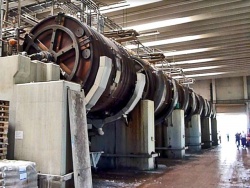
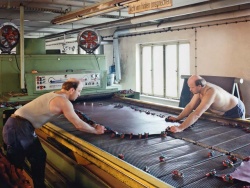
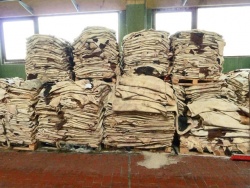
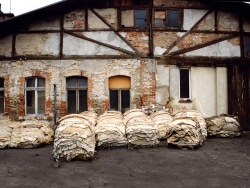
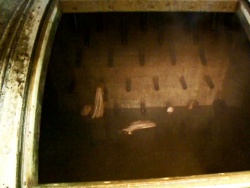
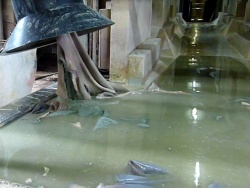
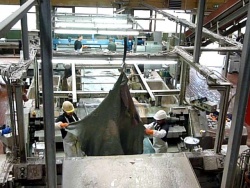
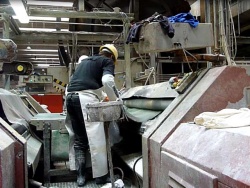
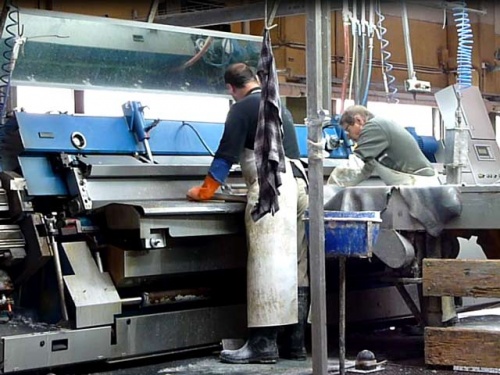
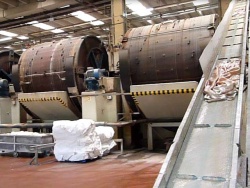
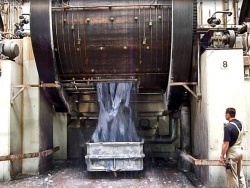
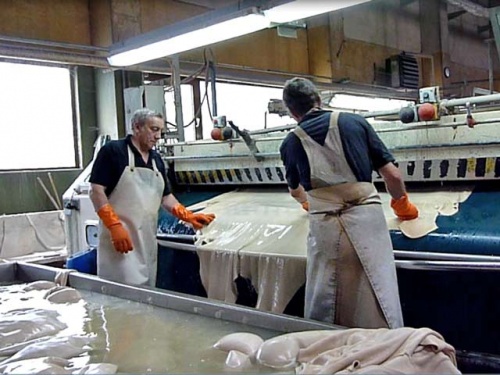
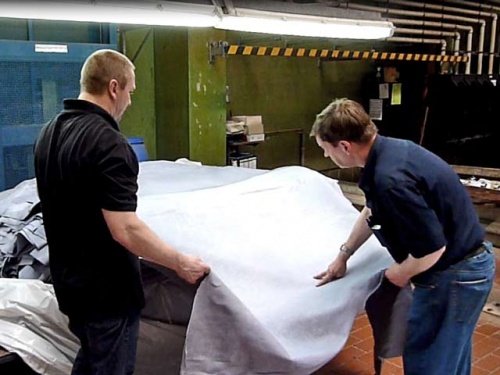
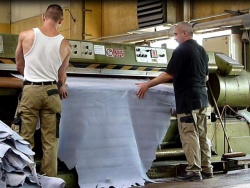
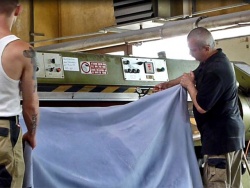
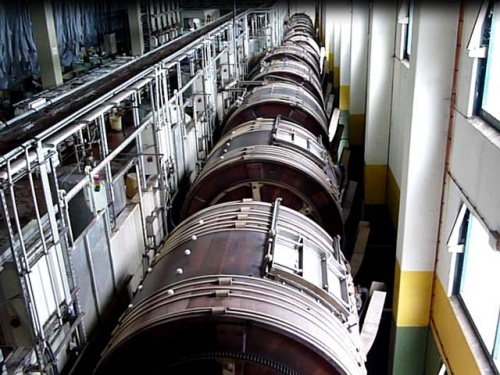
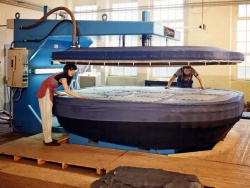
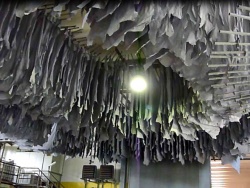
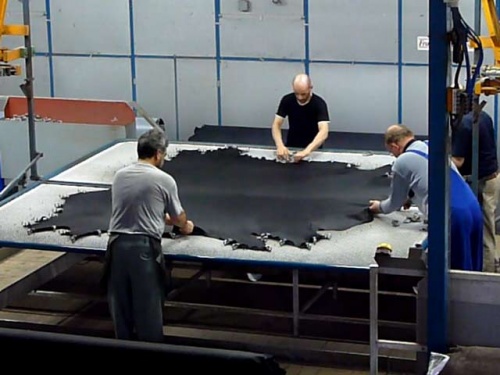
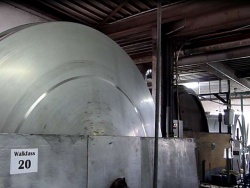
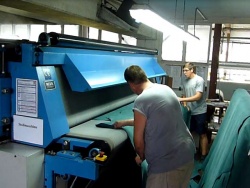
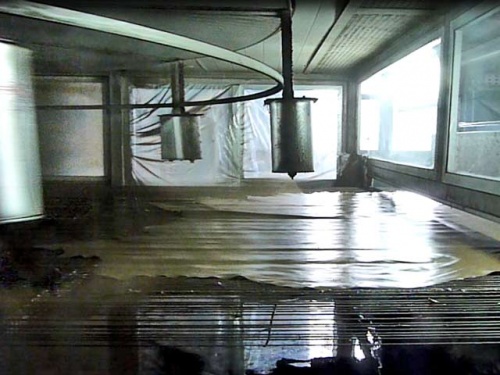
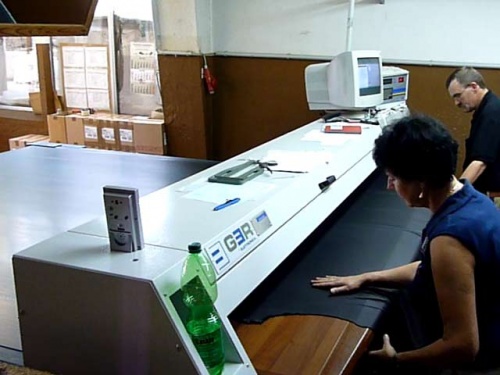

 a kotori web solution
a kotori web solution